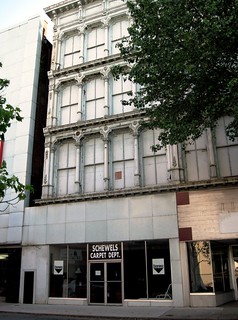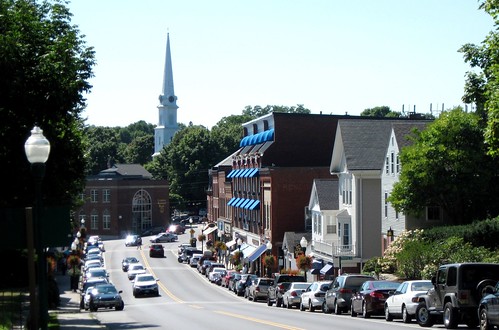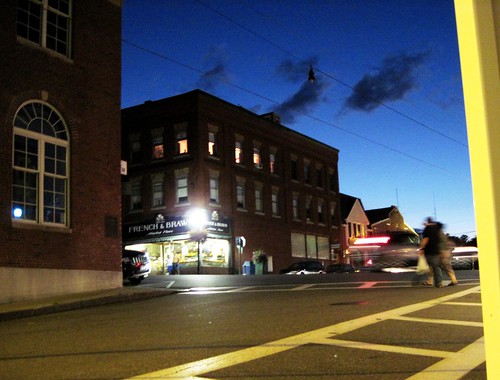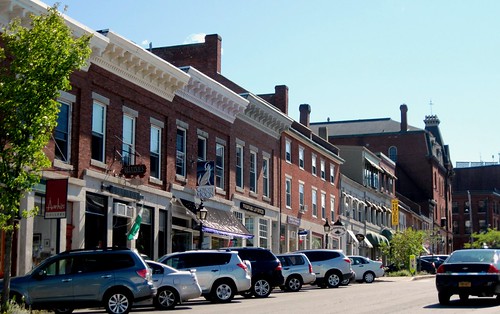The fall - and rise - of small downtown America (by Lee Epstein)

Posted September 7, 2012 at 1:37PM
A few years ago, I co-authored a post here that featured the small town in which I grew up in Pennsylvania. I tried not to be nostalgic, but the town did have many of the design features that help define sustainable, smart growth: a walkable street plan with short blocks and lots of alleyways, some moderate mix of uses and densities, easily accessed daily destinations like schools and libraries, parks and playgrounds, a grocery store and small restaurants, and a lot of greenery. All of these features could have been strengthened, but all in all, not a bad small town model.
Note from Kaid: Today I offer another post by my friend and frequent collaborator, Lee Epstein. Among other good things, it gives me an opportunity to post some small-town and small-city photos I have taken, some as recently as last week. Lee is an attorney and land use planner working for sustainability in the mid-Atlantic region. Now, back to his words:
A tale told too often
What I didn’t write about was local business disinvestment and downtown decline. I think it’s a cautionary tale, and unfortunately not a unique one across America.
For seventy years, my family ran a small business in the town just across the river, where most of the local commercial activities were located along the half mile-long Main Street. These included men’s and women’s clothing stores, shoe stores, jewelry stores, hardware stores, Woolworth’s and J.C. Penney’s department stores, optometrists, a movie theater, drug stores, and the like. Often, professional offices or apartments were located on the second or third floors. There were strip shopping centers a few miles away, but for the most part, the town thrived. Several things happened by the late-1960s that changed all that and quite deeply (and, as it turned out, fatally) challenged that model, spinning small downtowns everywhere into decline.

First, the interstate highway system was completed. No longer did people need to travel secondary roads that took them through commercial areas in small towns to get somewhere else, and the routes out to more “open” land were made quicker. So open land was where the newest thing landed like a space ship: the enclosed mall. Where better for shopping than air-conditioned, fully weather-protected spaces that pumped in canned music and canned fountains, where one could find national chain stores – and better yet, tons of free parking?
Second, local demographics and tastes or “lifestyles” changed. In many small towns there began an outflow of newly educated baby boomers looking for brighter lights and better jobs, leaving an aging population behind. At the same time, in the 1960s and ‘70s suburbia exploded, even in small towns. Why live in older housing stock with a neighbor just 30 or 40 feet away, when one could buy a nice, new house on a bigger new lot, in a bright new subdivision beyond the edge of town? And once living out there, wouldn’t it be easier just to drive out to the strip shopping center or the mall, rather than go into town and hassle with parking, in order to get to the drugstore or buy a new shirt?
Finally, local economies changed. Many small towns that had depended upon a local industry or natural resource as their biggest economic component and employer (think steel, coal, textiles or small manufacturing) saw the economies of such sectors shrink or the industry relocate elsewhere where labor or capital were cheaper. At the same time, big banks were swallowing small local ones, changing local financial relationships that had lasted fifty years or more.
(Of course, there’s also the drastic change in retailing that has occurred over the past ten years, as small independents fell by the wayside, and even the larger “brick and mortar” stores have felt increasingly pinched by the rapid rise of e-commerce.)
The legacy of disinvestment
The results of all these trends, taken together, included newly un- (or under-) employed workers, shrinking small town local economies, and struggling small businesses that had trouble obtaining operating loans and credit. Better to try to sell out if one could, or maybe just go out of business.
 As noted above, this is a tale told often, in perhaps thousands of small towns across America. It affects more than just the economies of these places, as mall-sprawl, in-town disinvestment, and highways and new subdivisions have created spirals of new land development that impact farm, forest, water, air, greenhouse gases, and socio-cultural stability. But is there any way to reverse course? Can we – should we – today try to take advantage of all that “sunk capital” in the form of infrastructure, all those historic buildings, the social and cultural connections and advantages offered in these kinds of communities, their “good bones”? Well, I’m not one for throwing stuff out (just ask my wife). Indeed, the designs of many of these places seem pretty darned close to the sustainable designs many of us now embrace.
As noted above, this is a tale told often, in perhaps thousands of small towns across America. It affects more than just the economies of these places, as mall-sprawl, in-town disinvestment, and highways and new subdivisions have created spirals of new land development that impact farm, forest, water, air, greenhouse gases, and socio-cultural stability. But is there any way to reverse course? Can we – should we – today try to take advantage of all that “sunk capital” in the form of infrastructure, all those historic buildings, the social and cultural connections and advantages offered in these kinds of communities, their “good bones”? Well, I’m not one for throwing stuff out (just ask my wife). Indeed, the designs of many of these places seem pretty darned close to the sustainable designs many of us now embrace.
The problem, however, is how. People disinvested in these downtowns for a reason -- actually, for the multiple reasons detailed above. Can these places get investment back? The answer for some is probably not. If a natural resource-based industry stopped producing, the reason was likely that the resource (in my own instance, Pennsylvania hard coal) was mostly played out (and so, unfortunately, was the scarred, strip-mined land above and around it). Certain other industries (for example, textiles) went south for a while, then to Central America and Asia. American steel mills are shadows of their former selves.
But the good news is that in pockets of small town America, either a bit of manufacturing has returned, or in other places, some re-purposing of older buildings is occurring -- I think of some of the mill towns in New England that have turned some of their wonderful old buildings into apartments and new shops, and are trying to capitalize on those previous investments. Other communities may be undertaking some planning work that starts with determining what the community’s vision for itself is, and then focuses on figuring out what the challenges and opportunities are (or what the barriers are and incentives might be) to realizing that vision.
After all, by mid-century, there will be another 100 million Americans. While there are fewer of the big industrial giants than there were before, there may be medium or small ones looking around for a place to land. The U.S. still has a $15 trillion economy, and more than one fifth of it is in manufacturing. There are some 30 million small businesses in the U.S. Then, of course, there is the rise of the service and “knowledge” businesses, which can locate pretty much anywhere.
Using existing assets to leverage renewal
What can small towns do to increase their economic competitiveness, to attract industry and new businesses to town, or to recreate themselves? Should or can they do things differently this time, so as to protect themselves against another round of disinvestment in the future as lifestyles or business forms and profiles change, or the next big (commercial) thing lands with a thud?
Focusing on community assets is the first key to attracting investment attention. Is there a river to which the town can be better connected, or are there other natural resources nearby to be enjoyed – mountains, lakes, hiking and nature photography, fishing and hunting – which can help “sell” the town, and to which transit, biking, or walking connections can be better made? Are there solid buildings ready to be re-occupied, maybe in imaginative ways? Are there good educational or medical resources nearby -- a school, a college, a technical institute, or a hospital? These are community assets which might be leveraged – maybe even in imaginative financial ways (see further, below).
 Changing zoning to help make the town more commercial- (and mixed use)-friendly can also be beneficial: are there businesses not currently allowed “by right” which should be? Can density/intensity downtown be boosted a little, and some additional housing be accommodated? Can residents of the area be “invited” back downtown in some way? Once the regulations are right, it’s easier to reach out to developers or market the town to business brokers.
Changing zoning to help make the town more commercial- (and mixed use)-friendly can also be beneficial: are there businesses not currently allowed “by right” which should be? Can density/intensity downtown be boosted a little, and some additional housing be accommodated? Can residents of the area be “invited” back downtown in some way? Once the regulations are right, it’s easier to reach out to developers or market the town to business brokers.
If need be, can a Main Street that may have been taken over by four lanes (or more) of fast-moving cars be “calmed” with better design and traffic control? Can the street be “greened” with street trees, planters, and innovative stormwater management practices that serve dual functions?
Can the main thoroughfare and side streets be made more pedestrian-friendly and walkable? Can in-town parks be improved, or streams that run through the community be cleaned up and made into local assets? Can the local farming/ranching community be brought into the picture, to develop together various value-added economic activities for their goods – and even tourism? Can the community use zoning outside of town to protect those working lands, or better conserve open space in general and focus any new growth back downtown?
Sustainability as a strategy
Beyond the kinds planning, zoning, and economic development solutions noted above, there’s a set of new ideas out there which could make an important difference in certain communities that may already have a few key assets already on hand. This school of thought might eschew almost entirely the “traditional” economic development approach (which usually involves searching for “savior” industries and the holy grail of landing clean, new businesses).  Gar Alperovitz, Thad Williamson, and Steve Dubb discuss these alternatives in a recent article in the July 2012 edition of the on-line magazine, Solutions Journal.
Gar Alperovitz, Thad Williamson, and Steve Dubb discuss these alternatives in a recent article in the July 2012 edition of the on-line magazine, Solutions Journal.
In their view, just doing the same thing as the last time around leaves towns that have already experienced commercial and economic decline vulnerable to yet another wave of disinvestment when the newcomer manufacturers decide a few years later, based on the bottom line and the near total mobility of capital these days, to pull up their stakes and move where the grass is even greener – or at least cheaper -- yet again.
Instead, these authors suggest it may be time to opt for a more sustainable approach to reinvestment and commercial renewal. They offer a variety of solutions, some of which apply to larger communities, cities and regions in distress. But one idea worthy of note here is that a community of any size could develop a “green community wealth building” approach (my emphasis). This strategy would look to create forms of business ownership anchored directly in the community itself.
This approach would use financial investments directly provided by local private institutions (for example, the so-called “eds” and “meds” -- the hospitals and specialty clinics or colleges and universities in town or nearby, though this could also apply to key banks or a town’s largest businesses), as well as public entities, to foster locally created, green businesses with different forms of ownership and not the usual business objective. From non-profits and employee-owned firms, to public enterprises and neighborhood-owned businesses, such enterprises could produce goods and services in town, in sustainable ways. There may even be charitable foundations in the region or state willing to help jump-start such activities, with technical start-up assistance or investment.
All of the above takes some hard thinking in small towns that find themselves today in pretty rough circumstances. It also takes good planning, intensive outreach, and steady leadership by politicians and the private sector. Finally, it takes good old fashioned salesmanship and marketing – and ultimately, not a little luck.
But I say it’s all worth it.
Of course, not every small town commercial center can come back; some may be just too far gone, or unfortunately just don’t enjoy the circumstances (location, human capital, or proximity to even modest investment opportunity) that can help them move forward. On the other hand, many still do have an awful lot to offer, in both urban form and just plain human possibility. To them, I wish all the best-- because they just may be among the best places for green community-building in the future.
Related posts:
- Let's link the working rural landscape to the sustainability agenda (with Lee Epstein) (March 1, 2012)
- How a small community is becoming greener - with help from some important friends (September 19, 2011)
- Smart growth investment may be key to small cities' economic vitality (September 15, 2011)
- The link between thriving towns and a sustainable rural landscape (March 18, 2011)
- How to strengthen a town with prudent investment and common sense (January 25, 2011)
- Images of hope from a town where 'reinvention is the only option' (Braddock, Part 2) (October 14, 2010)
- Walkable livability is a small-town value (April 6, 2010)
- Smaller cities can benefit from revitalization, too (September 9, 2009)
Move your cursor over the images for credit information.


